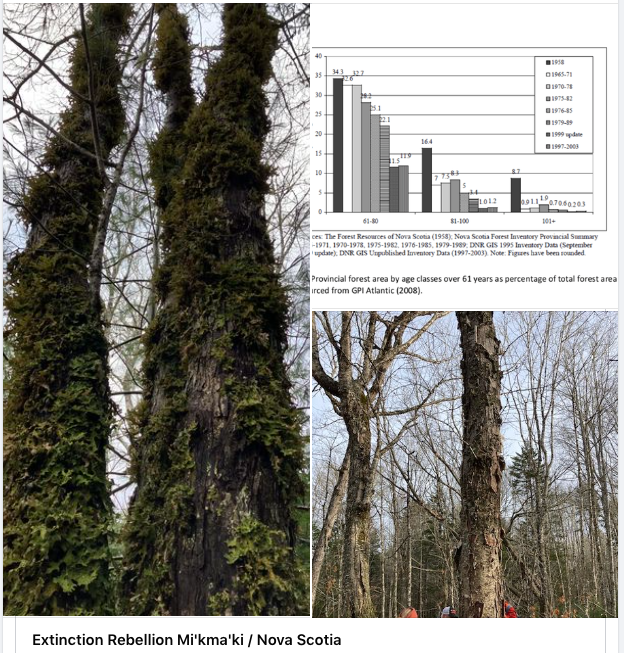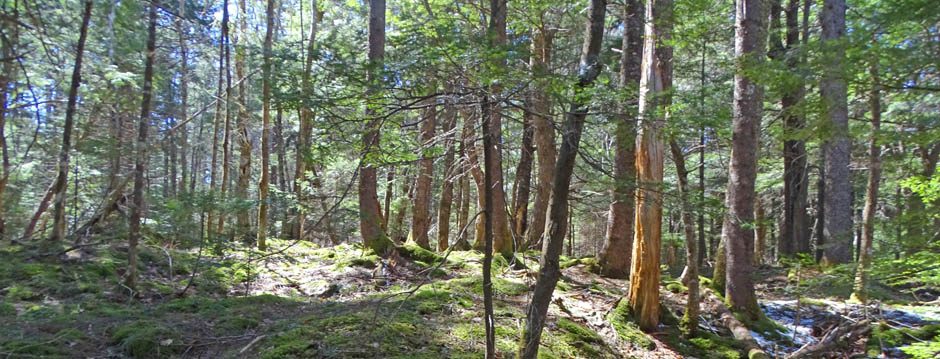From post on Extinction Rebellion Mi’kma’ki / Nova Scotia, Dec 9, 2022
 While the UN Summit on tackling the Biodiversity Crisis is underway in Montreal, here in Nova Scotia citizen scientists are highlighting for our government the biodiversity of our few remaining old forests.
While the UN Summit on tackling the Biodiversity Crisis is underway in Montreal, here in Nova Scotia citizen scientists are highlighting for our government the biodiversity of our few remaining old forests.
Old forests support more complex ecosystems and that means they support more variety of life. If we want to address the biodiversity crisis in Nova Scotia, we have to protect old forests. It’s not the only thing we need to do, of course, but it is a place to start.
In 1958 the province’s own statistics show that forests over 80 years old made up 25.1% of our forests. By 2003 that figure was down to 1.5%. And what has happened since then? Well, we don’t know. You see the province changed the kind of statistics it keeps and the way it collects them. They stopped keeping track of the age of our forests. The Lahey report noted the lack of good publicly available information about the state of our forests. In an appendix to the Lahey Report, the Mersey Tobeatic Research Institute drew attention to the fact that we can no longer compare the state of the forests now with their state in, say, 1958 or even 2003. They recommended the province keep using the old method of gathering data from aerial photographs if they had no other way to provide data that would allow us to compare past and present. But the province has not done that.
The Nova Scotia Nature Trust estimates that only 0.6% of the forests in our province are over 100 years old. In 2003 that figure was 0.3%. Are things getting better for the forests? Well, we don’t know. What we do know is that forests on ‘Crown’ land have been under relentless pressure from industrial forestry. Even now, with growing awareness of the catastrophic consequences of nature loss for human society (let alone for all the rest of nature), that pressure continues.
The few old, biodiverse forests remaining on ‘crown’ land – obvious candidates for inclusion in the 20% of Nova Scotia’s lands this government has committed to protecting by 2030 – are being approved for logging by this same government.
The citizen scientists documenting the variety of life found in the old forests surrounding Goldsmith Lake in Annapolis County are glad when they discover Species At Risk – 9 to date including one occurrence of Nova Scotia’s newly chosen provincial lichen, the Blue Felt lichen, and seven Frosted Glass Whiskers lichen.
It is good that the Department of Natural Resources and Resources has responded to these discoveries by placing a freeze on any harvesting activities in the area around Goldsmith Lake until a professional lichenologist hired by WestFor can survey the area.
It is also good that DNRR’s Resource Manager for the Western Region has responded to information about the age of some of the forests that are not currently classified as Old Growth by requesting a forester assess these forests to see if they do meet the province’s new criteria for Old Growth.
The trouble is that we are long past the point where 100 meter buffer zones and miniscule additions to the category of Old Growth Forest will be enough to protect and restore ecosystem health in our degraded forests. We have to protect habitats, not individual lichen specimens. We have to protect older forests now if we want more old forests later. Citizen scientists know this. UN scientists have made no secret of their alarm as we enter a Sixth Mass Extinction. Biologists have established that the catastrophic drop in the number of birds in the Maritimes that depend on old forests is linked to – you guessed it – the loss of old forests. Surely biologists within NRR and ECC know this.
How difficult can it be to put a temporary freeze on harvesting and road-building in the forests around Goldsmith Lake until a decision can be made – based on science and Indigenous Consultation and public input – on whether the area should be included in the 20% of our lands that will receive permanent protection? Isn’t this what should happen to all the forests over 80 years old on ‘crown’ land?
So far ECC appears to be planning to make plans to protect 815,000 acres sometime in the future. Meanwhile it is circular filing proposals like the one submitted by the Citizen Scientists to protect three areas of high ecological value on ‘Crown’ land in Annapolis County including Goldsmith Lake.
NRR says it is too late to protect Goldsmith Lake, the harvest plans have been approved. They were approved in spite of strong comments opposing the logging plans once these were posted on the obscure government website where such plans briefly see the light of day — a site where the public is told any comments they make based on context (such as the climate and biodiversity crises and the massive clearcutting of the surrounding forests) will be ignored.
But it’s not too late for Goldsmith. If we want a liveable planet it can’t be too late for Goldsmith Lake and all the other lakes and rivers and wetlands and forests, the oceans and the islands, the whole glorious astonishing natural world that is our only home.
The question is, what will we do to protect our home?
